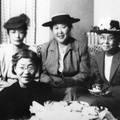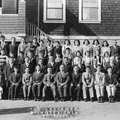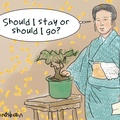Allan Arima “Life was pretty simple”
Allan Masayoshi Arima, was born in 1931, delivered by a midwife named Mrs. Watanabe, who he said was well-known in the community. His parents, Itaro and Same Arima came from Kagawa prefecture in 1921. He said he was known as “Mush” (presumably short for Masayoshi) and shared stories about his life in Marpole for the Sedai video project produced by the Japanese Canadian Cultural Centre in Toronto.
His father worked as a labourer for BC Box Lumber, making 15 cents an hour. In 1939, he killed in an industrial accident at the mill, when he was fifty-two and Mush was eight. “I never really got to know my Dad and it was something I really missed growing up…”
His mother was a housewife, like many other Japanese Canadian women at that time. She began working on Saturday mornings. Her eldest daughter Takako went with her to translate. Takako and his other sister Toshiko went to Magee high school. After school, they stayed with different hakujin families to do housework for five dollars a week. They returned home on weekends.
His family rented the first floor of a two-storey house on Selkirk in the heart of the Japanese Canadian community, from Sentaro and Shika Suzukis, the grandparents of David Suzuki.
Mush recalled buying chicken from Mrs. Suzuki.
“She would go to the chicken coop, grab a squawking chicken and brought it to a large tree stump, which served as a chopping block and chop its head off with an axe. The blood would be spewing all over, while the chicken danced crazily for a few moments. She would hand me the dead bird and I would take the chicken home, holding its feet while the blood drizzled to the ground. Upon returning home, I would help my mother pluck the chicken even though I dreaded the chore and to this day, I cannot handle a live chicken, but I still enjoy eating chicken, cooked, of course.”
“Life was pretty simple. I went to David Lloyd George public school and later on the same day, the Japanese Language School.”
He did not recall having any hakujin friends at school or outside of school. Here he speaks about his last day of school, with Principal Harvey.
“I do recall going to school after the bombing and having Betty, a blonde girl with freckles calling me a ‘Jap.’ I wasn’t sure what it was all about. Japan’s attack on Pearl Harbor hadn’t affected me yet. Life was still the same. One day in the early months of 1942, Mr. George Harvey, the principal, called all the Japanese kids into his office to tell us that this was our last day at the school. I can’t recall if he had an explanation as to why we were being dismissed, but his last words were, ‘I hope to see you, all of you back at the school.’ Of course, that never happened.”
Esther Matsubuchi “The Japanese community was quite vibrant.”
Esther Matsubuchi grew up Esther Yorimi Sunohara on Osler Street. Esther Matsubuchi spoke to us online with the help of her daughter, Wendy Matsubuchi.
Esther’s parents, Junichi and Mii Sunohara, came from Nagano prefecture. Esther’s mother was born in 1906 and came to Canada as a picture bride when she was 16.
Junichi worked a gardener for the head of the E.B. Buckerfield Seed Company. Mii worked at the house as a domestic.
She spoke to her older brothers about their recollections of the Japanese Hall on Selkirk Street.
“They remember the Community Centre where they went to Boy Scouts on Friday nights and it was quite a big community centre and the Japanese community was quite vibrant and there was grocery stores and everything Japanese.”
The family lived in a house owned by the Buckerfields and were supposed to be given it, until “the War broke out and so that was all cancelled.”
David Suzuki “You still look like a Jap to me.”
In his first memoir, Metamorphosis — Stages in a Life, David Suzuki writes about the ice boxes when he grew up in Marpole in the late thirties. He remembered chasing horse-drawn ice wagons to pick up fallen pieces of ice as a treat in the summer. He recalled being amazed at his father removing a block of ice kept in sawdust bin in the back since the winter.
He also shared an exchange with a kid that perhaps illustrates some of the challenges of living in the community.
We lived in the back of our dry-cleaning shop, next door to our Canadian neighbours, the McGregors. Their youngest son, Ian, was my age and my best friend. One day a new boy who had moved in down the street approached Ian and me. The boy told Ian not to play with me because I was a Jap. At that point I shot back,
“But I'm a Canadian, just like you. I speak English, don't I?”
He reluctantly agreed.
“I eat the same kind of food as you.”
Hesitant acknowledgement.
“My clothes are the same as yours.”
“Well, I guess you're right,” he finally admitted. “You must be a Canadian — but you still look like a Jap to me.”
Joy Kogawa: “I longed to go back to that house”
Joy Kogawa was born Joy Nozomi Nakayama in 1935. She spoke to us over Zoom.
The family moved into the house when Joy was two. They had been living in an apartment in Kitsilano, which was in the Church building where her father worked. In recent years, the house has been saved and now operates as the Historic Joy Kogawa House, serving as a home for writing.
“I was shy about everything, but I remember at the end of our block, there was a Gospel Hall. And I can remember at one point, I think I was four years old, I was picked up and put up on stage, which was embarrassing. I was required to sing John 3:16, ‘For God loved the world but He gave His own begotten Son who should ever be not perish but should have everlasting life.” So I remember standing there on stage and feeling horrible because of all this attention and then having to say that. So I said that and then one of the Steeves brothers said to me later, ‘You were crying,” and I said, ‘I was not crying.” I don’t think I was crying. But I think I was really nervous.”
She had memories of going to the kindergarten at St. Augustine and even some of the songs they sang. At five, she took the streetcar on her own.
And later, perhaps the beginning of her literary career.
“I remember the first day of school, at the David Lloyd George School, and making bread…that was what we did the first day. I remember it was delicious. And I remember how we were taught to read and how we used our fingers as rulers along the words.”
The place now called the Historic Joy Kogawa house is a 1912 Craftsmen style bungalow with lots of wood panelling inside. It had two bedrooms. One for the parents and one subdivided for Joy and her brother Timothy. They had large cedars, a peach tree and apple tree in the yard, though not a cherry tree.
“I remembered that house of my childhood all the rest of the time after we were removed from it. I longed to go back to that house.”
*This article was originally published in Nikkei Image, 2002 Spring, Volume 27, No. 1.
© 2022 Raymond Nakamura






